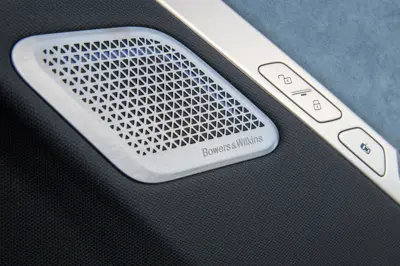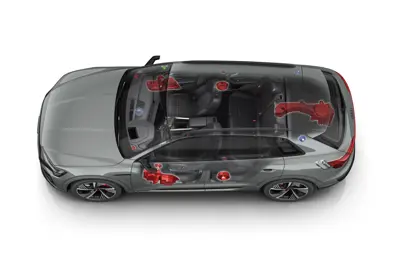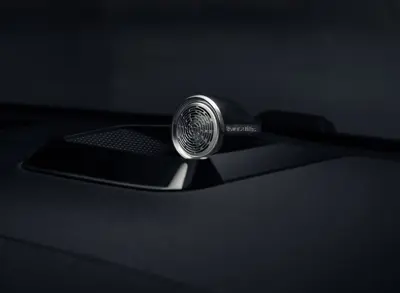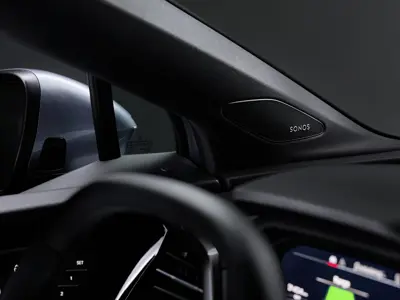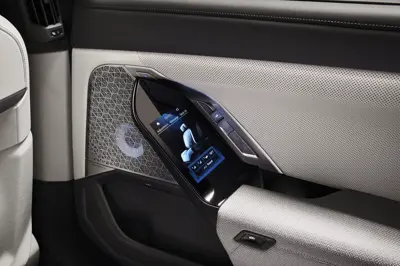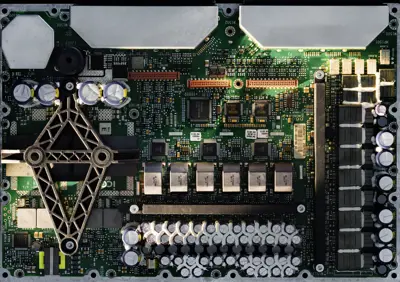Audio System
When buying a car, many customers pay particular attention to the audio system. That is because the car is specifically where people listen to music enthusiastically and frequently.
Electric vehicles (EVs) are considered better for listening to music compared to fossil fuel cars for several reasons:
Quieter Environment: EVs are quieter than fossil fuel cars, resulting in less noise interference and clearer music. Without internal combustion engines, which produce loud and variable sounds, EVs offer a more serene environment. Additionally, EVs have less vibration and friction from mechanical parts, enhancing the sound quality of the speakers and audio system.
More Space and Flexibility: EVs offer more space and flexibility for installing sound systems and speakers. Without the need to accommodate fuel tanks, exhaust pipes, or other components, EVs provide more options for speaker placement and audio equipment customization. Advanced features like wireless connectivity, voice control, and digital assistants can further enhance the music experience.
Consistent Power Supply: EVs provide a more consistent and stable power supply for sound systems and speakers. Using batteries that deliver constant and regulated voltage and current, EVs ensure reliable audio performance. Unlike fossil fuel cars that rely on alternators, which can fluctuate and cause distortion, EVs minimize the risk of power surges or spikes that could damage the audio system or speakers.
Car audio systems have evolved significantly from the early days of AM/FM radios. Today, they are an integral part of the driving experience, significantly enhancing the enjoyment of road trips and daily commutes.
In this article, we will explore the various components of a modern car audio system, including speakers, amplifiers, head units, and more. We will also discuss the importance of selecting high-quality components and provide tips for achieving the best sound quality in your car.
Speakers
Speakers are the most critical component of any car audio system. They convert electrical signals into sound waves, allowing us to hear music, podcasts, or audiobooks while driving. There are several types of speakers available for car audio systems, including component speakers, coaxial speakers, and subwoofers.
Speaker Types
Component Speakers: These are the most expensive and offer the best sound quality. They consist of separate drivers for the tweeter, midrange, and woofer, allowing each driver to focus on a specific frequency range for clearer, more detailed sound.
Coaxial Speakers: More affordable and easier to install, coaxial speakers combine the tweeter and woofer into a single unit, resulting in a more compact design.
Subwoofers: Designed to handle low-frequency sounds, subwoofers are usually installed in the trunk or a custom enclosure.
Speaker Locations
Speakers are typically installed in various locations within the car's interior, depending on the size, shape, and design of both the car and the speakers. Common locations include:
- Dashboard: Small speakers aimed at the windshield to create sound reflection, often used for high-frequency sounds like tweeters.
- A-pillar: Small speakers for high-frequency sounds, such as tweeters.
- Doors: Larger speakers aimed at passengers to create direct sound, often used for mid-range and low-frequency sounds like woofers and mid-range drivers.
Rear Deck: Large speakers aimed at the rear window to create sound reflection, often used for low-frequency sounds like subwoofers.
Headrest: Some audio systems have speakers mounted in the headrest.
Depending on the type and quality of the audio system, a car may have different numbers and combinations of speakers in these locations. Some cars may have only two or four speakers, while others may have six, eight, or more. Some cars may also feature component speakers (separate units for different frequency ranges) or coaxial speakers (combined units for different frequency ranges). Additionally, some cars may include amplifiers or equalizers to enhance or adjust the sound quality of the speakers.
Amplifiers
Amplifiers increase the power of the audio signal and drive the speakers. They come in various sizes and power ratings, and selecting the right amplifier is critical for achieving the best sound quality. Amplifiers are typically classified by their number of channels, with mono, two-channel, four-channel, and even six-channel amplifiers available.
Head Units
The head unit is the brain of the car audio system, responsible for playing music, controlling volume, and adjusting equalizer settings. Head units come in various forms, including single-DIN and double-DIN sizes, and can include features such as Bluetooth connectivity, GPS navigation, and touchscreen displays.
Equalizers
Equalizers allow you to adjust the balance of different frequencies in your music. They can be integrated into the head unit or come as a separate component. A good equalizer can help you fine-tune the sound to your liking and compensate for any deficiencies in your speakers or amplifier.
Wiring
The wiring of a car audio system is crucial for achieving the best sound quality. High-quality wiring can minimize signal loss and noise, resulting in clearer sound. It is essential to use the correct gauge of wire for each component, and all connections should be secure and properly insulated.

